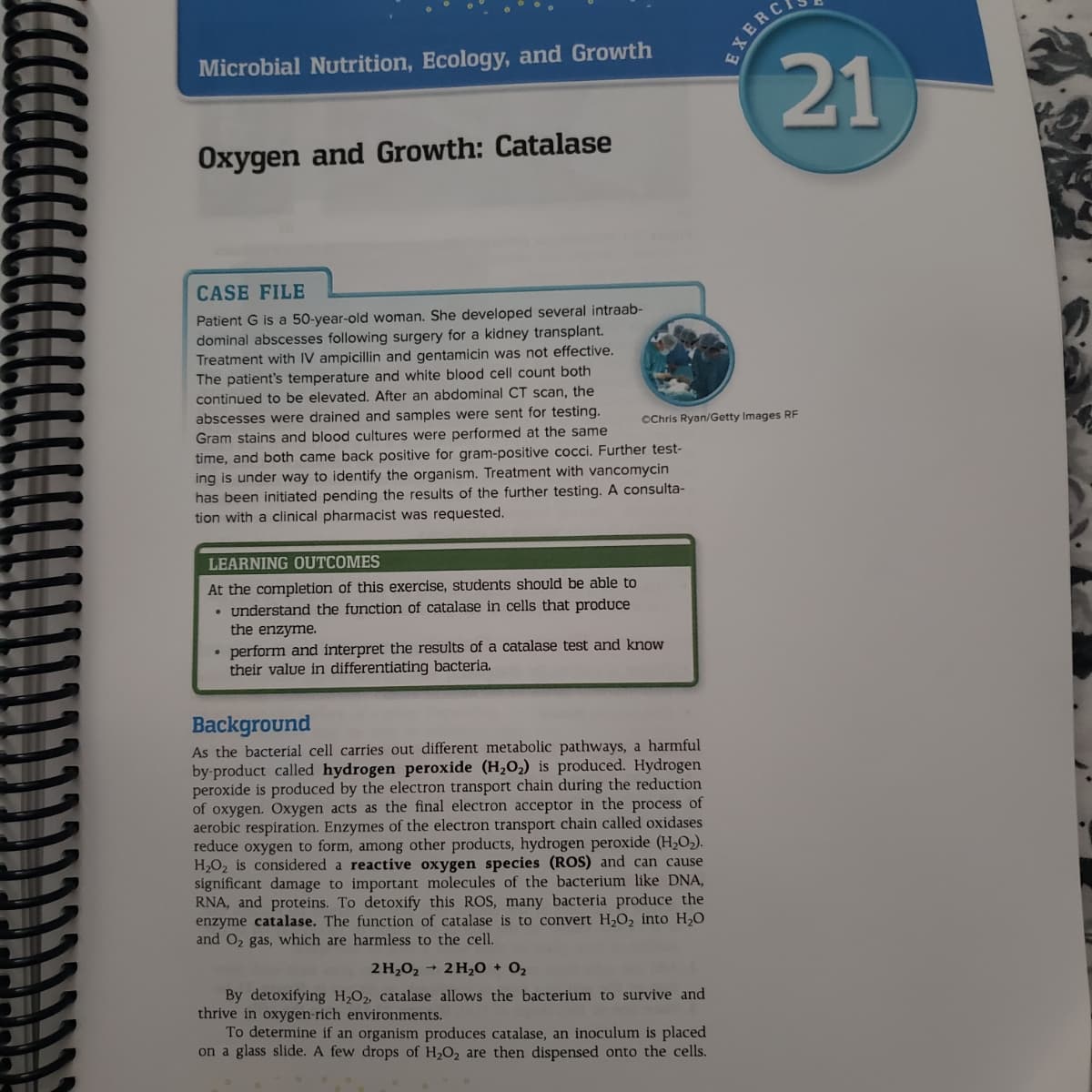If the result of the catalase test came back positive and the doctor decided to run a coagulase test what do you think the result would be and why? Explain.
If the result of the catalase test came back positive and the doctor decided to run a coagulase test what do you think the result would be and why? Explain.
Basic Clinical Laboratory Techniques 6E
6th Edition
ISBN:9781133893943
Author:ESTRIDGE
Publisher:ESTRIDGE
Chapter7: Basic Clinical Microbiology
Section7.1: Introduction To Clinical Microbiology
Problem 13RQ
Related questions
Question
Please read the case file from exercise 21 (Catalase, pg. 127) in your manual. After reading the case file please answering the following:
6. If the result of the catalase test came back positive and the doctor decided to run a coagulase test what do you think the result would be and why? Explain.

Transcribed Image Text:Microbial Nutrition, Ecology, and Growth
EXERC
21
Oxygen and Growth: Catalase
CASE FILE
Patient G is a 50-year-old woman. She developed several intraab-
dominal abscesses following surgery for a kidney transplant.
Treatment with IV ampicillin and gentamicin was not effective.
The patient's temperature and white blood cell count both
continued to be elevated. After
abdominal CT scan, the
abscesses were drained and samples were sent for testing.
Gram stains and blood cultures were performed at the same
time, and both came back positive for gram-positive cocci. Further test-
ing is under way to identify the organism. Treatment with vancomycin
has been initiated pending the results of the further testing. A consulta-
tion with a clinical pharmacist was requested.
OChris Ryan/Getty Images RF
LEARNING OUTCOMES
At the completion of this exercise, students should be able to
• understand the function of catalase in cells that produce
the enzyme.
perform and interpret the results of a catalase test and know
their value in differentiating bacteria.
Background
As the bacteríal cell carries out different metabolic pathways, a harmful
by-product called hydrogen peroxide (H,O2) is produced. Hydrogen
peroxide is produced by the electron transport chain during the reduction
of oxygen. Oxygen acts as the final electron acceptor in the process of
aerobic respiration. Enzymes of the electron transport chain called oxidases
reduce oxygen to form, among other products, hydrogen peroxide (H2O2).
H2O2 is considered a reactive oxygen species (ROS) and can cause
significant damage to important molecules of the bacterium like DNA,
RNA, and proteins. To detoxify this ROS, many bacteria produce the
enzyme catalase. The function of catalase is to convert H,O2 into H20
and O2 gas, which are harmless to the cell.
2 H202 + 2 H,0 + 02
By detoxifying H,O, catalase allows the bacterium to survive and
thrive in oxygen-rich environments.
To determine if an organism produces catalase, an inoculum is placed
on a glass slide. A few drops of H2O2 are then dispensed onto the cells.
Expert Solution
This question has been solved!
Explore an expertly crafted, step-by-step solution for a thorough understanding of key concepts.
This is a popular solution!
Trending now
This is a popular solution!
Step by step
Solved in 2 steps

Knowledge Booster
Learn more about
Need a deep-dive on the concept behind this application? Look no further. Learn more about this topic, biology and related others by exploring similar questions and additional content below.Recommended textbooks for you


Microbiology for Surgical Technologists (MindTap …
Biology
ISBN:
9781111306663
Author:
Margaret Rodriguez, Paul Price
Publisher:
Cengage Learning


Microbiology for Surgical Technologists (MindTap …
Biology
ISBN:
9781111306663
Author:
Margaret Rodriguez, Paul Price
Publisher:
Cengage Learning